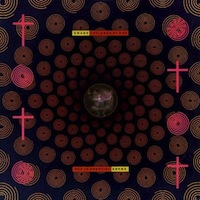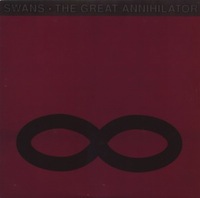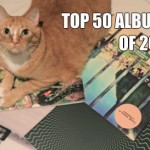Beginner’s Guide: Swans

Beginner’s Guide is a new feature that aims to provide readers with entry points into the catalogs of artists with complicated, massive, or sometimes difficult discographies. It’s not a completist’s guide, but instead a way of introducing an artist to a listener so that they might be able to navigate through deeper waters after a few spins. So come on in — there’s a lot to discuss.
Greed. Filth. The Great Annihilator. Public Castration Is a Good Idea. Read these titles on the spines of a band’s catalog of records, and you’re likely to recoil, flinch, or be transfixed by the sheer venom. This is the world of Swans, the decades-long musical outlet for New York artist Michael Gira and a rotating cast of musicians that has found a new way to make music simultaneously more intense and more sublime with each new step of its evolution.
To try to capture Swans’ music in one word, phrase or even sentence is practically impossible. Everything they’ve done, to a certain degree, is definitely dark, with moments of beauty, horror, abstraction, and all points in between. And if you spin their discography like a globe to find a random point of entry, where you land could very well find you listening to anything from industrial and noise rock to ambient or folk. Swans cannot be defined by genre or style. At their loudest, at their strangest, or at their most gentle, they are Swans, and you know it when you hear it.
Michael Gira formed Swans in 1982, choosing the name for its evocation of something beautiful with a nasty temperament. Come to think of it, that’s a pretty accurate way of summarizing the group, which began as a by-product of the no wave scene in New York, and even briefly featured Sonic Youth’s Thurston Moore in its lineup. But in time that harsh, noisy beginning gave way to primal noise rock on Filth, punishing industrial on Holy Money, transcendent gothic rock on Children of God, dark Americana on The Burning World, shoegazing post-punk on The Great Annihilator and eventually a little bit of everything on Soundtracks for the Blind — only to be resurrected in 2010 with a greater sense of purpose and some of their best material to date.
There’s a lot of material in Swans’ catalog, and trying to pry one’s way into their world is daunting if not outright confusing. Albums and EPs are collected in different compilations, some with missing material, some with extras. They have an unusually large collection of live albums, some of which are poorly recorded and some of which come packaged with extremely misanthropic titles. So where does one begin with Swans? Glad you asked. Follow me — in order — on a trip through Swans for beginners, through five of the band’s best, most essential albums.
Also, listen to our Essential Swans playlist on Spotify.
 Children of God (1987; Caroline)
Children of God (1987; Caroline)
Pinpointing a proper starting point for a band like Swans — whose catalog is so broad, diverse, and frankly terrifying — requires stepping back and surveying the numerous directions and incarnations they took with each phase of their career. But there’s one important period that stands out as perhaps the most important development (at least regarding Swans Mk. 1) — the addition of expressive, classically trained and altogether creepy vocalist Jarboe. She’s become an icon of experimental and heavy music, having collaborated with the likes of Neurosis, Cobalt and Justin Broadrick, as well as serving as a heroine to a new generation of gothic vocalists. And when she joined Swans in 1985, they became an entirely new band.
On Children of God, a strong contender for Swans’ greatest album along with several others included here, Jarboe and Michael Gira provide compelling counterpoints to each other. But to call this a “Beauty and the Beast” type match-up is misleading to say the least. Their partnership is more like a tag-team match between a werewolf and a ghost. Gira’s tracks are harsh and menacing, like the virulent industrial stomp of “New Mind,” the primal scream/occult sacrifice ceremony of “Beautiful Child,” or the brutal explosion of “Blind Love.” Jarboe, however, delivers not so much a raw, visceral serving of terror as something much more subtly eerie. Her highlights include the ethereal “Blackmail” and the breathtaking “In My Garden,” which is easily one of the prettiest songs in the entire Swans catalog. The title track, a closing capper on an overwhelming and awe-inspiring collection, is where Gira’s menace and Jarboe’s otherworldly chill come together in a glorious fusion, Swans standing atop the rubble of a crumbled civilization and broadcasting their death-drone until the light of the last star burns out.
 The Great Annihilator (1995; Invisible)
The Great Annihilator (1995; Invisible)
“In,” the first track on Swans’ The Great Annihilator, sounds like the gates of hell opening, a soundtrack to an unholy ritual with blood-streaked foreheads and darkened cloaks. And it ends with the sound of a child laughing. It’s peculiar. A little twisted. But it also reflects a lighter side of Swans. And yes, as hard as it is to find sometimes, it’s definitely there. And it shows its head pretty frequently on The Great Annihilator, despite the fact that this is still a dark, punishing release. It is Swans, after all. On The Great Annihilator — certainly one of their most ominous album titles — tracks of pure menace jut up against ascendant takes on dream pop (“Warm”), shoegaze (“My Buried Child”), and even an alt-rock single of sorts (“Celebrity Lifestyle”).
Those lighter moments — and that term is relative — set apart The Great Annihilator as having a unique position within Swans’ catalog. But they also serve to cast a powerful contrast against the tracks in which Swans concentrate their power on something more forceful and massive. These are tracks like the breathtakingly intense “Mind/Body/Light/Sound,” the unexpectedly catchy title track, and the ethereally gothic “Where Does a Body End?” Swans have done heavier albums, louder albums, darker albums and more confrontational records, but few are as endlessly listenable as The Great Annihilator.
 The Seer (2012; Young God)
The Seer (2012; Young God)
“Accessible,” when it comes to Swans, is a relative term. Their most arguably commercial album, The Burning World — the band’s sole major label release — was out of print for a long time and generally not a strong representation of the band’s sound or scope, even if its gothic country sound is still plenty enjoyable. Their second most accessible album (again, “arguably”), is 1995’s The Great Annihilator, which you just read about. But not too far below that on the approachability scale is The Seer, the band’s 2012 masterpiece, perhaps even the greatest thing the group ever released.
Now, looking at a two-CD/three-LP behemoth that boasts at least two tracks that end up being split on different sides because of how damn long they are, it’s easy to be intimidated by the sheer scope of the thing. And you’d be forgiven for doing so. Still, that shouldn’t get in the way of being able to sink into its apocalypse grooves or hypnotic doom ceremonies. The Seer, for how dark, ominous and punishing it can be, is actually a highly melodic album. Karen O of Yeah Yeah Yeahs shows up on “Song for a Warrior,” which is an understated, beautiful folk song, while Gira’s old musical partner Jarboe lends her voice to the choir on the swagger-heavy doom stomp of “The Seer Returns.” But there’s even greater thrills to be found in some of the longer tracks, like the end-times psychedelic dirge “Avatar,” and the album’s most awe-inspiringly powerful track, “The Apostate,” which runs a lean 23 minutes. Certainly, The Seer takes patience, which is why it’s the third Swans album you should hear rather than the first. It’s not a casual listen. It is, however, an essential one.
 White Light From the Mouth of Infinity (1991; Young God)
White Light From the Mouth of Infinity (1991; Young God)
Michael Gira has been famously critical of the middle period of Swans’ career, particularly 1989’s The Burning World, which he called, in a Vice interview, a “colossal failure.” However, he did save a handful of tracks on it on a compilation of 1988-1992 material called Various Failures, which taken collectively actually make for a pretty powerful chapter in the band’s history, particularly when distilled to the most potent tracks. Still, I have a bone to pick with his decision to chop up 1991’s White Light From the Mouth of Infinity into chunks and spread them out all over a two-disc set of bits and pieces, odds and ends, rather than just reissuing the whole thing on CD or vinyl (it’s still readily available digitally, for what it’s worth).
As hard as it is to say that any Swans album is representative of the whole — only Children of God fits that bill, and to a certain extent, The Seer — White Light blends their most melodic and accessible elements with moments of eerie darkness. You can hardly call it Swans Lite — no Swans is lite, not even The Burning World, really. But on a track like “Song for the Sun,” you don’t really hear the band as a force of darkness as perhaps a pagan cult that worships the natural world, welcoming its beacon of shining life with open arms and booming voices. But White Light maintains a gothic atmosphere throughout, coloring tracks like the candlelit psych-folk of “When She Breathes” a deeper shade of Type O. Sometimes it takes shape in grand, ornate arrangements, as in opening destroyer “Better Than You” or “Why Are We Alive?” Sometimes it carries a propulsive gallop, like on “Power and Sacrifice.” And sometimes it’s so beautiful it’s terrifying, like “Song for Dead Time.” Presumably, when Gira dubbed the two-disc compilation of ’88-’92 tracks Various Failures, he was referencing the track “Failure,” which appears on both that comp and White Light From the Mouth of Infinity. One thing’s certain though — one song title aside, there’s nothing even closely resembling a failure on this record.
 Soundtracks For the Blind (1996; Young God)
Soundtracks For the Blind (1996; Young God)
Buy at iTunes
Whether or not a Swans album could be considered “beautiful” is largely in the ear of the beholder. There are definitely moments on many of their albums in which the group’s approach achieves a breathtaking transcendence. And even when Swans are pounding away in an attempt to open up the earth’s core and have every living soul swallowed whole by the bubbling, boiling crevasse, there’s something definitely awe-inspiring about what they do. But there is, actually, one Swans album that’s beautiful by more traditional definition, though no less dark or even, at times, disturbing. That album is Soundtracks For the Blind.
The longest album in the Swans catalog at 141 minutes, it’s an overwhelming amount of material to take in. In fact, it’s a good album to build up to, for as the album that marks the moment at which Swans were put on hold, it presents a glorious climax to a chaotic and continuously shifting career. Less of a post-punk or industrial album as much of the Swans catalog is, Soundtracks For the Blind is an eclectic mix of different sounds and approaches, ultimately ending up as a post-rock art piece more than a proper rock album. Conceptually speaking, it deals heavily with death, loneliness and finality. There are spoken-word recordings of phone-sex operators, Gira’s father discussing his loss of eyesight, and the sound of a child singing, which is a recurrent sound in much of the band’s recordings. Many of the songs are instrumentals — some ambient drones, some repetitious gothic rock — and four of the strongest tracks on the album, such as the magnificent “Helpless Child,” are more than 10 minutes apiece, each one an odyssey unto itself. Some songs reference older points in the band’s career, and some of the recordings date well back to the earliest incarnation of Swans. It’s the entirety of Swans contained in one epic, subdued closing act. This was a beautiful death.
Also Recommended: The Cop/Young God/Greed/Holy Money compilation collects four of the band’s mid-‘80s records, during the period in which the band was at its most uncompromisingly brutal, but maintained a sense of melody and even kind of danceable rhythms. Danceably brutal that is.
Also, 2010’s My Father Will Guide Me Up a Rope to the Sky is an excellent album, not quite as menacing or immense as its successor, The Seer, and a bit closer in style to Gira’s other project, Angels of Light. Still, it’s loaded with great songs, notably the slowly creeping dirge “Jim,” which grows into a seething beast very gradually (from a mildly ticked beast, natch).
Advanced Listening: It’s no secret that there are parts of Swans’ catalog that are pretty raw, and pretty harsh, no matter how much you dig a track like “A Hanging.” Their debut album Filth is one of those intensely harsh records, not as demonic in its scope as some of their best records feel, just abrasive and far less melodic. Similarly, the dark, droning live album Public Castration Is a Good Idea is better to work up to.
On the other hand, the band’s least abrasive album, 1989’s The Burning World, is also the least representative of the band’s sound on the whole, and though it did eventually get reissued after a brief, ill-fated major label partnership, Gira himself has more or less written it off. It’s still pretty good, but it doesn’t feel much like Swans.
You might also like:



Jeff Terich is the founder and editor of Treble. He's been writing about music for 20 years and has been published at American Songwriter, Bandcamp Daily, Reverb, Spin, Stereogum, uDiscoverMusic, VinylMePlease and some others that he's forgetting right now. He's still not tired of it.

